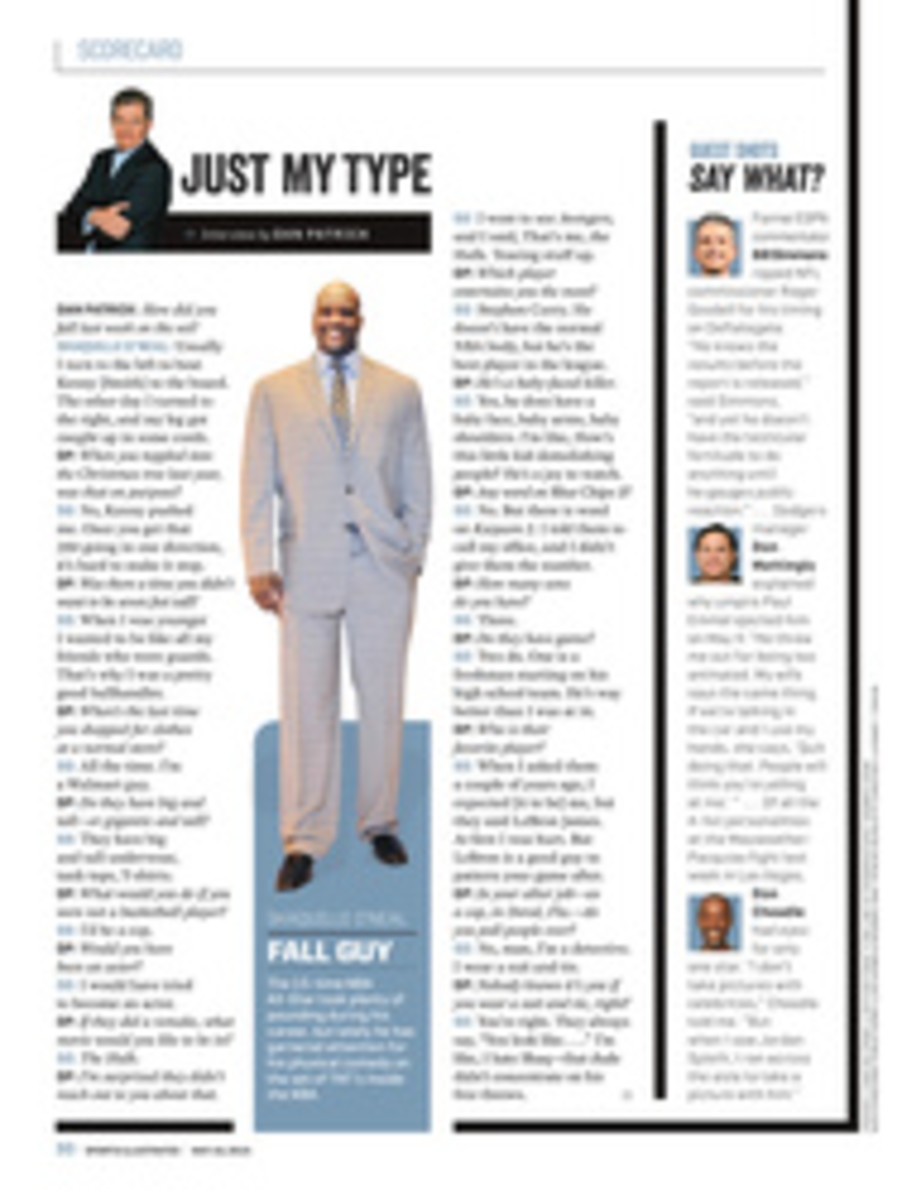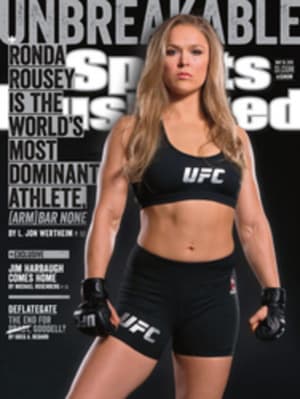
The Blake Effect
There's so much more to Blake Griffin's game these days than vicious dunks. (Just ask the Spurs and the Rockets.) The Clippers' power forward has rebuilt himself into one of the league's most complete players—brick by brick
ONE OF the most memorable plays of Blake Griffin's career, by his own estimation, was a colossal failure. It happened two years ago against the Warriors in Oakland, when his teammate, Clippers point guard Chris Paul, had the ball as the shot clock dipped under five seconds. The Golden State defense pinched off Paul's path as he drove to the hoop, so he dished to the 6'10" Griffin, who was standing in the corner at the three-point line.
Griffin's defender, Andris Biedrins, was about 10 feet away, but like everyone else in the league at the time, he had so little respect for Griffin's ability to hit a long jumper that he didn't even take a step to contest the shot. He simply turned to wait for the inevitable rebound. Wide open, Griffin set his feet, measured the shot and released a jumper that would have been perfect—had the rim been high on the side of the backboard, which is where the shot hit before caroming out-of-bounds. The crowd jeered, and some of the Warriors' reserves nearly fell over laughing.
The embarrassment of that scene pops into Griffin's mind just as often as the time he soared over a compact car to win the 2011 Slam Dunk Contest or the moment in a '10 loss to the Knicks when he elevated so high that he rested his forearm on 7'1" Timofey Mozgov's head as he stuffed the ball through the iron. Those kinds of moves built his reputation as perhaps the NBA's most powerful dunker, and, as Griffin says, "there are worse things to be known for." But it bothered him that the title came with the implication that he would never be anything more.
That assessment was as off-target as his wayward jump shot. Now that Griffin has evolved into a more complete player, no one is laughing, certainly not the Spurs or the Rockets, who have gained firsthand knowledge of his ever-expanding abilities. Griffin has been an all-around marvel this postseason, a 251-pound power forward with more than a dash of point guard in him. His coast-to-coast trips, on which he snatches the rebound on one end and finishes with a dunk or a dish on the other, often with a behind-the-back dribble en route, are feats no other power forward in the league can pull off as nimbly. (With the exception of LeBron James, a power forward when he wants to be.) With Paul hindered by a balky left hamstring, Griffin has kept the Clippers afloat, displaying shooting, playmaking and leadership skills to go along with his well-known athleticism around the basket. "It's been amazing to watch him," says Paul. "His whole game, everything he's worked so hard on, has come together. He's cranking out triple doubles on the regular."
Griffin has three of them in these playoffs, with two against San Antonio in the first round, including one (24 points, 13 rebounds and 10 assists) in Game 7. The third (26, 14 and 13), two days later, was against the Rockets in Game 1 of the Western Conference semis, a series the Clippers took command of 3--1 on Sunday with a 128--95 drubbing in Los Angeles. The box scores are bulging with his accomplishments, which have put him in rare statistical company—the only other players who conjured at least three triple doubles in the first eight games of a postseason are Wilt Chamberlain, Oscar Robertson and Magic Johnson.
"He's always had a good handle, and he's been able to use that a little more to attack, and his ability to use the dribble handoff and get other people shots is impressive," says Houston coach Kevin McHale. "He had a lot of talent to start out with, and now he's become a better basketball player."
IN CASE you haven't been paying close attention, the time has come to reconsider most of what you thought you knew about Griffin. That "just a dunker" description hasn't fit him for more than a year. He threw down 84 times during 2014--15, 18th in the league; that's fewer than half of his 176 dunks during the previous season, the fourth-highest total. But the label has stuck with him because it's easier to fix a jump shot than to change a narrative. Griffin was the chiseled leaper, living with that "great athlete" tag that complimented his physical gifts while discounting the time and effort he put into sharpening his skills. Then, too, there was Griffin the deadpan pitchman, the Kia commercial comedian whose fame had outpaced his accomplishments. That might have led to Griffin the hard-foul magnet, the target of multiple takedowns over the years by opponents who seemed eager to egg him into a fight.
Elements of all those different Griffins are still in evidence. He was flattened, for instance, by Rockets center Dwight Howard on a dunk attempt on Sunday but kept his composure. "My entire career everybody has said I need to punch somebody, and I haven't," Griffin says. "But hard fouls are a part of playoff basketball."
The Griffin who has been the least known all along was the one who put in hours at the gym, working on his weaknesses. He estimates that he has put up more than 250,000 jump shots over the last few years with his shooting coach, Bob Thate, remaking his jumper "brick by brick," he says, in every sense of the term. Griffin broke bad habits—bringing the ball too far behind his head, releasing it on his way down instead of at the top of his jump, leaning back when he should have been jumping straight up and landing in the same spot—by repeating the proper form until it was second nature.
His passing skills didn't need to be sharpened as much, but Los Angeles coach Doc Rivers has brought them to the forefront. Rivers put Griffin in position to operate from the elbows, giving him the option to shoot, drive or pass. He also asked him to turn and face defenders more often when he got the ball in the low post instead of trying to back them down. "That's the area to me in which he made his biggest improvement," Rivers says. "He's very difficult to guard when he turns and faces, because you can't put your hands on him. Then with his first step, his quickness and his vision, he's just impossible."
Not that long ago it was impossible to imagine the habitually pathetic Clippers franchise in the Western Conference finals, but after their Sunday demolition of the Rockets, that's where they appear to be headed for the first time in their history, and Griffin, more than ever, is responsible for leading them there. The Clips have been Paul's team for the four seasons the point guard has been in L.A., but lately Griffin has been making leadership of the team into a two-man operation.
When the Rockets began intentionally fouling center DeAndre Jordan, a 41.7% career free throw shooter, early in Game 4, it was Griffin who made sure that Jordan didn't get frustrated by the treatment. "We don't give him any choice, to be honest," Griffin said. "At halftime I said to him, 'Look at everything they did to try to slow the game down, and we're still up by six.' He could have missed every free throw, but he still would have done things that gave us a chance to win. We tell him every day that his impact on a game goes way beyond some missed free throws."
Likewise, Griffin's impact on a game goes far beyond some acrobatic dunks. The Clippers are shooting for the first championship in franchise history, and unlike that night in Oakland two years ago, Griffin's aim is true.
"Everything he's worked so hard on has come together," says Paul. "He's cranking out triple doubles on the regular."
PHOTO
Photograph by John W. McDonough for Sports Illustrated
JUMP AROUND Griffin racked up 22 points and 14 rebounds in a Game 3 blowout of the Rockets, his 10th straight double double to start the playoffs.
PHOTO
Photograph by John W. McDonough for Sports Illustrated
RUN WITH IT Griffin's handle has made him a one-man fast break who's as much a threat to find the open man as to finish himself.

